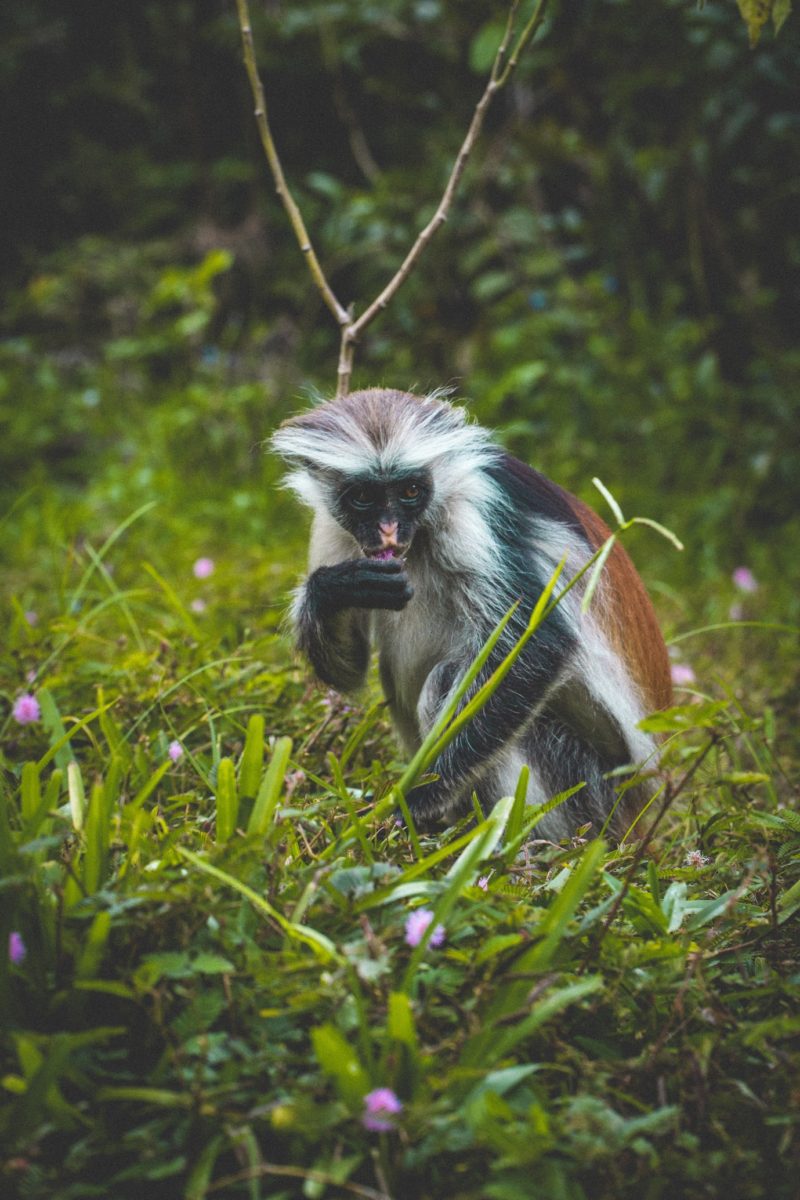Jozani Forest
Jozani Forest, also known as Jozani Chwaka Bay National Park, is the only national park on the African island of Zanzibar. It covers a small area of 50 kilometers square off the central east coast but is an oasis of tranquility in an otherwise bustling tropical paradise.
One must-see tour of Zanzibar Island is a trip to Jozani forest. As soon as you enter under the lush canopy of towering palm and other trees, it’s no wonder why this place has been protected since the 1960s.
The fascinating thing about the forest tour is that it truly serves as a natural pharmacy full of plants and trees used for medicinal remedies by locals for centuries. Every plant or tree cures something ranging from headaches, fever, or sprains, and every plant in this amazing source of natural remedies has its own story behind it. Apart from medicinal benefits, one can witness plenty of endemic animals, such as red colobus monkeys, Bush babies, and Sykes monkeys, among others, during their stay at this natural paradise. The beautiful thing about the Jozani forest tour is that the height of hardwood trees, mangrove forests, and palms is outstanding.
History & Origin
Jozani Forest, a unique national park in Zanzibar, Tanzania, has survived hundreds of years on the African continent. Initially, it was founded as a forest reserve in the early 1960s where most travelers came to hunt for something very rare: the captive animals, particularly the elusive Zanzibar leopards. It was only after 1984 that this place was turned into a national park to protect its precious wildlife.
Looking back at this transformation into a protected area, it is evident that it was essential to preserve these amazing species; otherwise, some of them might no longer exist today. For example, the Zanzibar leopard is believed to be extinct due to an unconfirmed sighting back in 2003; however, there are still scattered reports from travelers who tell stories of their observation, although none could ever be proven true.
Opening Times & Entrance Fee
The official opening times are 7:30 am to 5:00 pm every day. If you plan your trip right, you could get a great deal since June to September is the dry season in Zanzibar. Considering that it’s not fun to walk through the park on a rainy day, contact your tour agency and find one that will fit your schedule.
Although you can technically arrive at Jozani Forest on your own, it is important to note that it’s impossible to visit without a tour guide. Thankfully, that isn’t something extra you need to pay for, as hiring one will be already included in many packages and offers. And speaking of price, the entrance fee to the national park is quite affordable compared to other parks within Africa, so don’t worry about breaking your budget!
How to Get to Jozani Forest
Jozani Chwaka Bay National Park, located in the East of Zanzibar, is an excellent destination for nature lovers who want to discover this small island’s diverse flora and fauna. Though it’s relatively easy to find your way there, if you don’t have your car or prefer being guided by someone more familiar with the area, the easiest way is usually as part of an organized tour. It depends on the area and type of accommodation you stay at, but most hotels all around the island offer excursions to Jozani Forest. At the same time, they come in different lengths, typically between half and full-day experiences.
Especially from Stone Town, there are many options for half-day tours that include snacks and a leisurely boat ride across some mangroves before getting to the park. Regardless of which one you choose, they provide a great introduction to its stunning wildlife, such as Red Colobus Monkeys and various species of birds or butterflies. Thanks to its convenient location, halfway between Stone Town and Michamvi Kae, where I stayed at Marumbi Beach Hotel & Spa, the park is easily reachable from most parts of Zanzibar either by car or taxi. For example, I was less than 45 minutes away in my driver’s car from Michamvi.
What to See at Jozani Forest
Red Colobus Monkeys
The Jozani Forest in Zanzibar is the only place in the world where the rare Red Colobus Monkeys can be found. The forest is over 6,207 acres in size and was declared a nature reserve in the 1960s. The species were endangered, but their numbers have increased in recent years. Jozani is also home to 50 different species of butterflies and 40 species of birds, Bushbabies, and the incredibly rare Zanzibar Sykes’ monkey, unique to this part of Tanzania.
The reserve has become an important destination for tourists seeking a glimpse at the last remaining habitats for these special primates. Visiting tourists should keep out noise, respect the wildlife and other visitors, not leave any trash behind, adhere to all safety regulations, and stay on walking trails throughout the park to ensure the sustainability of this remarkable area.
Small Antelopes
The secluded forests of Zanzibar are home to a selection of rare and elusive species of antelopes. The most popular animal to spot at the Jozani Forest in Zanzibar is the Aders’s duiker, a small to medium-sized brown antelope. It’s the rarest antelope species in Africa and only found in this region, with numbers estimated between 300 and 600. If you’re lucky enough to spot one, it’ll be a sighting that everyone around you will remember for years to come!
The Aders’ Duiker is especially alert and sensitive to sound, so you need some extra luck if you want a glimpse of this beautiful creature. Be aware that it may flee long before you realize what just ran through the undergrowth! In addition to being part of wildlife-watching trips, these shy mammals also show up in documentaries about African wildlife from time to time.
Another evasive mammal found at Jozani Forest is Kirk’s dik-dik – an even smaller antelope species than the Aders’s duiker. This shy mammal generally appears alone and camouflaged by the trees and dense brush, making them almost impossible to locate if they don’t want to be seen.
Remarkable Flora
Last but not least, one of the true gems of the island is the Jozani Forest. Home to some of the most remarkable flora and fauna that Zanzibar has to offer. You will find all sorts of unique and interesting species of plants and trees in this protected area. From 100-year-old Mahogany trees, whose wood is mainly used for furniture production, to many eucalyptus trees and various other plants with medicinal benefits, your guide explains it all to you. Much of what goes into local daily life, medicines, and tools come from this area.
However, in my opinion, the fascinating part is the mangrove area on the other side of the park. Mangroves are lush and dense trees specialized for living at sea levels higher than normal forests can adapt to due to their extensive root system – which you can even wade through if you have proper shoes on! All these amazing examples of native flora make up one remarkable forest which everyone should visit.
What to wear on Jozani Forest Tour
Are you planning on taking a tour of Jozani Forest? If so, what kind of things should you wear for the trip? The dress code for such tours is usually quite laid-back and casual. This relatively short tour lasts around two to three hours at most, so comfort is key. However, please bear in mind that since the local guides are Muslims, it would be courteous to refrain from wearing too revealing clothes, while female visitors should pay attention to this dress code.
Of course, this doesn’t mean that fashionable tees or shirts are off the table! Flip-flops and any other summer shoes make perfect sense as the paths in this beautiful forest are nice, and the boardwalk is made of wood – not suitable for trainers but fine with flip-flops.

